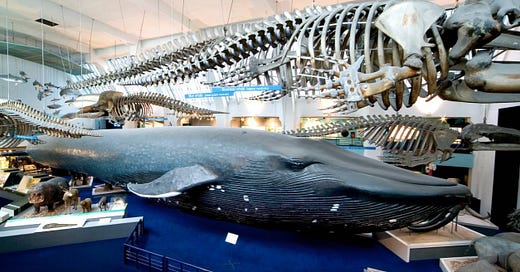Long before getting interested in cultural history, I was somewhat more engaged with natural history. This interest, which found primary expression in a few childhood visits to Colchester Zoo, London Zoo and the Natural History Museum, was to be superseded by other, perhaps less wholesome pursuits: from addictive computer games to adult horror novels, via late night confessional talk shows (on pirate radio). Then came the final and most corrupting rite of passage - a close acquaintance with the mid 1980s independent record charts. By the time I took possession of my first Smiths album, I had lost all interest in comparable avian wingspans, fish longevity, or running speeds for land mammals. Kensington Market, home to various examples of indie regalia, was thus soon to usurp Kensington’s finest museums.
But once, as I well recall, a stunning, full size, wood and plaster model of a blue whale, housed at NHM, was chief among points of interest. That remained a fact. There was a totally bonkers ‘whale in the room’. Their Victorian gallery was hardly big enough to house this 28m leviathan. It could not be apprehended in a single view. You could only edge around the massive flanks or pass dangerously under its belly.
For me it was the whale, then. For others, the NHM offered Dippy as a star attraction. I continue to reminisce, now about Dippy. They were another seeming folly, and also a crazy idea. This was a replica skeleton, as false as it was intrinsically structural, which assembled, in plaster form, the 292 bones once owned by a Jurassic-era sauropod. Yes, Dippy was a diplodocus specimen, unearthed in 1899, in Wyoming, USA, and I did think the model bones were swell, too; it mattered little that neither that whale nor Dippy the dinosaur were (what we think of as) the real thing; when young and your imagination is strong, differences between the actual versus the artificial are just a notional technicality.
Dippy has proliferated as replicas tend to do. The original still ‘lives’ in Pittsburgh; but between 1905 and 1932, amazingly, casts were dispatched to Berlin, Paris, Vienna, Bologna, St Petersburg, Buenos Aires, Madrid, Mexico City, and Munich, plus of course the NHM in London. It has been called diplodiplomacy though it is not clear how the sauropod has been nicknamed beyond the English speaking world. On these shores, Dippy has enjoyed plenty of recent action. A tour of UK museums has seen him/her stay for periods in Dorset, in Birmingham, in Belfast, in Glasgow, Newcastle, Cardiff, Rochdale, Norwich and now in Coventry. For a single example of a creature who last drew breath some 150 million years ago, that is quite a staggering afterlife.
Dippy’s bone count, which remains extensive, appears almost to be the fixture’s raison d’être. It would have have been easier, one expects, to make a fibreglass dinosaur with full musculature and skin. And indeed on home turf, outside the Carnegie Museum of Natural History there in Pennsylvania, onesuch model greets passersby on street level. In much the same way, it would have been possible for the NMH to settle for their 221 bone authentic skeleton of a blue whale. Nicknamed Hope by early curators, the bone whale, rather than the wooden whale, was beached off the Western coast of Ireland. This beast was another which could not have dreamed of their posthumous career.
They had the bones; but the model was needed. As a child I would dream only of that giant model. To be in its space was to be underwater with it. It is not what you would call a highly realistic model, as the museum acknowledges. But it did let me commune with the terrors of the deep, terrors I preferred to any realistic fears a child might get; it checked out against various picture books and it allowed me to enjoy the one quality which this model shares with Hope and Dippy: mere size, which is an urgent concern at such a tiny age.
From the earliest dioramas to the latest documentaries, presentations of the natural world can surpass its reality. Nature is an endless fund of things to reconstruct and then to gawp at. For the record, the hierarchy of attractions to be found in the NHM circa 1980 was, for me: 1) model whale; 2) model diplodocus; and then, 3) actual whale.





Data and idea packed thanks. I am, for some reason, reminded of Kate O'Riordan's discussion on mammoth s. Greetings from bus to Ireland, currently somewhere near Newport.
Thanks for giving this your time. I'd love to read Kate O'Riordan on mammoths. Will check it out, thanks.